D-Day remembered: The triumphs and tears of Normandy's fortunate few
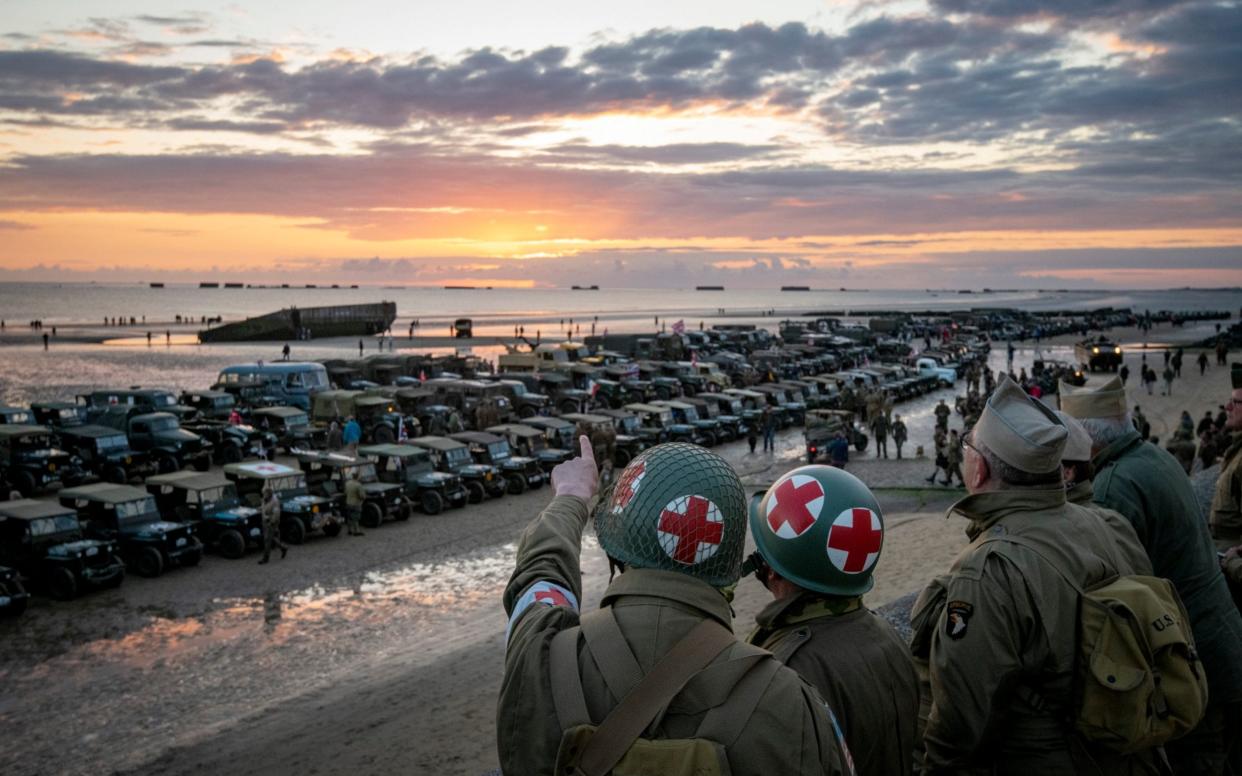
According to the Prince of Wales, it was "probably the last chance to pay everlasting respect" to the veterans of D-Day.
If the 75th anniversary does prove to be one last rallying of the troops, whose numbers are rapidly diminishing with age, then the nonagenarians of the Normandy landings certainly made it count with a loud last hurrah.
On Thursday evening in Arromanches-les-Bains - the French seaside town made famous as one of the key landing points of the Allied assault - veterans sung war songs, danced, waved flags and toasted with hip flasks filled with Calvados.
Their numbers, as the Prince suggested, have dwindled. Around 70 D-Day veterans marched in the parade compared with hundreds in previous years. But on the narrow winding streets of Arromanches, age has dimmed neither gratitude nor memory.
As the veterans paraded, backed by the regimental pipes and drums, families shouted "bravo", clapped their hands and stamped their feet in appreciation of the British troops who liberated them from the Germans. Arromanches even presented its own wreath to veterans "on behalf of a grateful town and country".
One woman embraced 94-year-old William Blount and kissed him on the cheek with a simple "merci". It was 75 years to the day since Mr Blount, then a Royal Marine gunner, was anchored off Juno Beach loading shells aboard a Landing Craft Gun vessel.
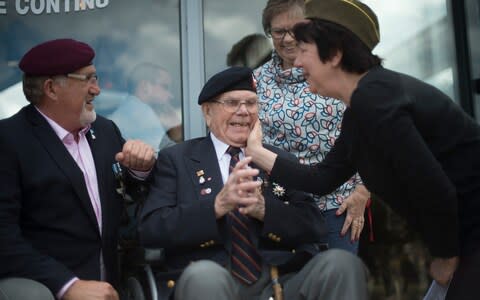
Theo Eaves, a 96-year-old RAF Bomber Command veteran, also found himself embraced by strangers. "I like meeting people and having kisses on both cheeks," he said, "but I also think of all the people who aren't here to enjoy it."
An RAF DC-3 Dakota and Spitfire in operational D-Day livery made three fly-pasts to rapturous applause from an audience including Penny Mordaunt, the Defence Secretary; Tobias Ellwood, the defence minister; and General Lord Dannatt, the former head of the Army.
As the afternoon sun dipped and veterans linked arms to sing Auld Lang Syne, the Red Arrows roared overhead, painting the sky red, white and blue.
A day of celebrations and commemorations started at 6.26am (BST), the exact minute the first British troops landed on the beaches of Normandy in June 1944.
Pipe Major Trevor Macey-Lillie performed from the top of a concrete section of the Mulberry harbour constructed by the Allies.
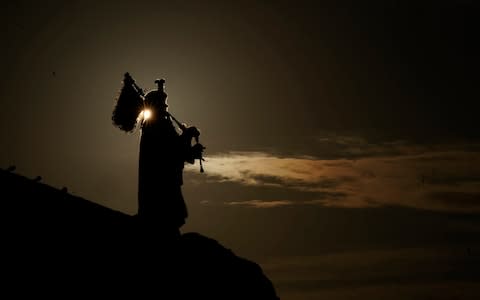
Hundreds of replica military vehicles shipped over to Normandy were parked on the beach, which still hosts the rusting remnants of a D-Day landing craft.
Throughout the day those well-trod wartime songs, White Cliffs of Dover and We'll Meet Again, so entrenched in the culture of this town, echoed from pavement cafes and bars.
Len Cox, a D-Day veteran of the 56th Brigade, 2nd Battalion, Gloucestershire Regiment, gave an impromptu dance performance to crowds vying for a photograph. "In the early days I used to jitterbug," he said. "Nowadays I couldn't get down on my knees like I used to or I'd probably never get up."
Amid the kitsch and swirling skirts, the sorrow of war was ever-present.
Late in the afternoon, 95-year-old Frank Baugh walked down the main town promenade of Arromanches, puffed chest glinting with medals.
Earlier in the day, he had addressed a crowd including the Prince of Wales, the Duchess of Cornwall and the Prime Minister, Theresa May, at the Commonwealth War Graves Cemetery in Bayeux.
On D-Day, the Royal Navy signalman was tasked with transporting 200 troops of 2nd Battalion, King's Shropshire Light Infantry from Newhaven to Sword Beach. On the way they received a direct hit, meaning the men had to jump into four feet of water.
"We were talking moments before but they were cut down by machine guns," he said. "They fell into the water, floating face down, and we couldn't get them out. That is my abiding memory and I can't forget it."
Three men from the unit killed that day are buried in Bayeux, among more than 4,100 other Normandy veterans. Speaking after the ceremony, Mr Baugh admitted it took him 65 years to return to Normandy. On Thursday he was surrounded by 11 family members. "It is important to pass on the experience to the next generation," he said.
There was no prouder standard bearer of the wartime generation than six-year-old George Sayer, who arrived at Bayeux wearing the beret and hat of his great uncle of the same name.
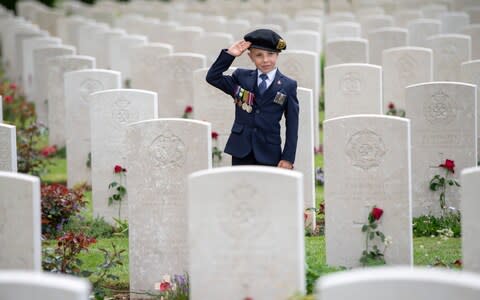
George Snr was among the first to land on Sword Beach at about 7.35am on D-Day and later helped to build the Mulberry harbours at Arromanches. George calls his great-uncle, who died 18 months ago aged 93, his "war hero".
Because he was wearing his great-uncle's medals, George was allowed to join the veterans on the traditional walk to the cemetery from an earlier commemorative service at Bayeux Cathedral. At noon, as the cathedral bells tolled, a hushed silence settled over Bayeux cemetery for the commemorative service to begin.
During the ceremony, those that could helped each other to their feet to sing I Vow to Thee My Country.
Mrs May delivered a reading that was briefly interrupted by a mistimed fly past.
After the Prince of Wales laid a wreath at the cross of sacrifice, followed by the Prime Minister, a long line of veterans stretched out to pay their own personal tribute.
Following the service the Prince and the Duchess swapped stories with the veterans and listened to their recollections of the landings.
One such encounter was with a man who worked with his grandfather, George VI. Alfred Hicks, 94, from Dorset, told him how he had spent time filming the King while working in a Royal Air Force film unit based at Pinewood Studios.
"So you knew my grandfather. I never really knew him," replied the Prince, who was three when George VI died in February 1952.
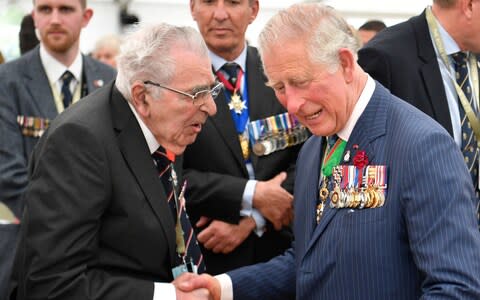
The Prince also met a veteran of the Royal Signals and the Parachute Regiment (of which he is commander-in-chief). Wearing a maroon beret and paras tie, Private Arthur Bailey, 95, from Portsmouth, finished off a story he had started telling the Prince the previous day during the national commemorative event on Southsea Common.
Aged 19, he landed on Gold Beach at 6pm on D-Day. "I can remember them all shouting out to us on the tannoys," he said. "They told us: 'Lads, the ramp is down. Everybody get off the ship. Good luck to you all.'"
Many of the final few survivors of the great invasion lied about their age in order to fight. John Cornwall, 92, was 17 when he landed on Gold Beach as a private in the Gloucestershire Regiment. He signed up as a 15-year-old after being rejected by another recruitment office.
"They chose youngsters to make the assault because we were the right age to take on a job like that," he said.
Mr Cornwall was part of the liberation of Bayeux and recalls scenes similar to those on the streets of Arromanches last night: "When we arrived people were waving flags, cheering and handing us drinks."
Three weeks later he was injured in a shell blast that reduced his left leg to two inches shorter than the other. Still, he counts himself among the fortunate ones. "One of the lads shot himself later," he recalls.
Another veteran present following the liberation of Bayeux was 94-year-old Michael Braine. A sub- lieutenant aboard HMS Waveney on D-Day, he was sent to Bayeux by his superiors to investigate, soon after Allied forces had moved in.
After hitching a lift inland aboard a lorry surveying the wreckage of the initial assault, he came across an open bar in the outskirts of the city and toasted the invasion with a glass of Dubonnet.
His trip to Normandy is his first for 50 years and, like so many here, is laced with bittersweet memory. The worst relate to the dying and wounded being hauled aboard his ship and calling out for loved ones.
"The ship's company rallied around wonderfully but it was never going to be the same," he says.
Even after all these years some of those present could still not bring themselves to relive whatever horrors they faced on the beaches of Normandy.
Royal Marine Norman Ashford, 94, of Coventry, attended the Bayeux service with his granddaughter Emma. Apart from saying that he was the coxswain of a landing craft on Gold Beach, he has never spoken to anyone about his experiences during his two months in Normandy - neither to his wife nor his fellow veterans. "Three of us agreed that we would only ever talk about it when the time comes... and it hasn't come yet," he said.
Their triumphs, like their tragedies, they will carry to the bitter end.

